The Impact of Indoor Living Wall System on Air Quality: A Comparative Monitoring Test in Building Corridors
Abstract
:1. Introduction
2. Methods
2.1. Location of the Study
2.2. Monitoring Conditions
2.3. Monitored Parameters and Sensors
2.4. Data Analysis
- (1)
- The form of two corridors are completely the same and they are symmetrical in the floor plan;
- (2)
- There was no statistically significant difference in the air change rate;
- (3)
- There was no statistically significant difference in the intensity of use of people.
3. Results and Discussion
3.1. Comparison of CO2 Concentration with and without ILWS
3.2. Comparison of Particulate Matter Concentration with and without ILWS
3.3. Comparison of Indoor Air Temperature with and without ILWS
3.4. Comparison of Indoor Relative Humidity with and without ILWS
4. Discussions
5. Conclusions
- ILWS could be a promising opportunity in the eco-design of the buildings considering its aesthetic value and purification function of indoor air.
- Based on the results from the statistical analysis, the differences in CO2 and PM concentration in the two corridors are statistically significant—this indicates the positive effect of ILWS on improving indoor air quality.
- In terms of the CO2 concentration, the average indoor air temperature of the corridors with ILWS can be reduced to the same level of outdoor condition, or even slightly lower than outdoor levels.
- The purification performance of CO2 and PMs in the heating season is better in comparison with that in the cooling season due to the local seasonal climate condition and pollutant emission.
- The effect of ILWS on indoor air temperature is quite limited. However, the relative humidity in the corridor with ILWS is slightly higher (3.1–6.4%) than that without ILWS.
Author Contributions
Funding
Data Availability Statement
Conflicts of Interest
Nomenclature
| VGS | Vertical greenery system |
| LWS | Living wall system |
| ILWS | Indoor living wall system |
| OLWS | Outdoor living wall system |
| CO2 | Carbon dioxide |
| PM | Particulate matter |
| VOC | Volatile organic compound |
| PAR | Photosynthetically active radiation |
| LED | Light emitting diode |
| PPFD | Photosynthetic photon flux density |
| MRE | Mean Relative Error |
| PM0.3–1 | The particle size is between 0.3 μm and 1 μm |
| PM1–2.5 | The particle size is between 1 μm and 2.5 μm |
| PM2.5–10 | The particle size is between 2.5 μm and 10 μm |
| average value of each measured parameter | |
| 15 days’ mean in the corridor with ILWS | |
| 15 days’ mean in the corridor without ILWS | |
| 15 days’ mean of outdoor environment | |
| concentration with ILWS by minute | |
| concentration without ILWS by minute | |
| outdoor concentration by minute | |
| daily reduction of the corresponding pollutants per square meter | |
| Rr | pollutant reduction ratio |
References
- Wilson, T. Population Growth. In International Encyclopedia of Human Geography, 2nd ed.; Kobayashi, A., Ed.; Elsevier: Oxford, UK, 2020; pp. 1–6. [Google Scholar]
- Liu, C.H.; Rosenthal, S.S.; Strange, W.C. The vertical city: Rent gradients, spatial structure, and agglomeration economies. J. Urban Econ. 2018, 106, 101–122. [Google Scholar] [CrossRef]
- Bek, M.A.; Azmy, N.; Elkafrawy, S. The effect of unplanned growth of urban areas on heat island phenomena. Ain Shams Eng. J. 2018, 9, 3169–3177. [Google Scholar] [CrossRef]
- von Schneidemesser, E.; Steinmar, K.; Weatherhead, E.C.; Bonn, B.; Gerwig, H.; Quedenau, J. Air pollution at human scales in an urban environment: Impact of local environment and vehicles on particle number concentrations. Sci. Total Environ. 2019, 688, 691–700. [Google Scholar] [CrossRef] [PubMed]
- Vieira, J.; Matos, P.; Mexia, T.; Silva, P.; Lopes, N.; Freitas, C.; Correia, O.; Santos-Reis, M.; Branquinho, C.; Pinho, P. Green spaces are not all the same for the provision of air purification and climate regulation services: The case of urban parks. Environ. Res. 2018, 160, 306–313. [Google Scholar] [CrossRef] [PubMed]
- Cai, M.; Xin, Z.; Yu, X. Particulate matter transported from urban greening plants during precipitation events in Beijing, China. Environ. Pollut. 2019, 252, 1648–1658. [Google Scholar] [CrossRef]
- Deng, S.; Ma, J.; Zhang, L.; Jia, Z.; Ma, L. Microclimate simulation and model optimization of the effect of roadway green space on atmospheric particulate matter. Environ. Pollut. 2019, 246, 932–944. [Google Scholar] [CrossRef]
- Charoenkit, S.; Yiemwattana, S. Living walls and their contribution to improved thermal comfort and carbon emission reduction: A review. Build. Environ. 2016, 105, 82–94. [Google Scholar] [CrossRef]
- Marchi, M.; Pulselli, R.M.; Marchettini, N.; Pulselli, F.M.; Bastianoni, S. Carbon dioxide sequestration model of a vertical greenery system. Ecol. Model. 2015, 306, 46–56. [Google Scholar] [CrossRef]
- Klingberg, J.; Broberg, M.; Strandberg, B.; Thorsson, P.; Pleijel, H. Influence of urban vegetation on air pollution and noise exposure–A case study in Gothenburg, Sweden. Sci. Total Environ. 2017, 599–600, 1728–1739. [Google Scholar] [CrossRef]
- Lacasta, A.M.; Penaranda, A.; Cantalapiedra, I.R.; Auguet, C.; Bures, S.; Urrestarazu, M. Acoustic evaluation of modular greenery noise barriers. Urban Urban Green. 2016, 20, 172–179. [Google Scholar] [CrossRef] [Green Version]
- Van Renterghem, T.; Forssén, J.; Attenborough, K.; Jean, P.; Defrance, J.; Hornikx, M.; Kang, J. Using natural means to reduce surface transport noise during propagation outdoors. Appl. Acoust. 2015, 92, 86–101. [Google Scholar] [CrossRef] [Green Version]
- Madre, F.; Clergeau, P.; Machon, N.; Vergnes, A. Building biodiversity: Vegetated façades as habitats for spider and beetle assemblages. Glob. Ecol. Conserv. 2015, 3, 222–233. [Google Scholar] [CrossRef] [Green Version]
- Oh, R.R.Y.; Richards, D.R.; Yee, A.T.K. Community-driven skyrise greenery in a dense tropical city provides biodiversity and ecosystem service benefits. Landsc. Urban Plan. 2018, 169, 115–123. [Google Scholar] [CrossRef]
- Mayrand, F.; Clergeau, P.; Vergnes, A.; Madre, F. Chapter 3.13–Vertical Greening Systems as Habitat for Biodiversity. In Nature Based Strategies for Urban and Building Sustainability; Pérez, G., Perini, K., Eds.; Butterworth-Heinemann: Oxford, UK, 2018; pp. 227–237. [Google Scholar]
- Dahanayake, K.W.D.K.; Chow, C.L. Studying the potential of energy saving through vertical greenery systems: Using EnergyPlus simulation program. Energy Build. 2017, 138, 47–59. [Google Scholar] [CrossRef]
- Poddar, S.; Park, D.Y.; Chang, S. Simulation Based Analysis on the Energy Conservation Effect of Green Wall Installation for Different Building Types in a Campus. Energy Procedia 2017, 111, 226–234. [Google Scholar] [CrossRef]
- Morakinyo, T.E.; Lau, K.K.; Ren, C.; Ng, E. Performance of Hong Kong’s common trees species for outdoor temperature regulation, thermal comfort and energy saving. Build. Environ. 2018, 137, 157–170. [Google Scholar] [CrossRef]
- Coma, J.; Pérez, G.; de Gracia, A.; Burés, S.; Urrestarazu, M.; Cabeza, L.F. Vertical greenery systems for energy savings in buildings: A comparative study between green walls and green facades. Build. Environ. 2017, 111, 228–237. [Google Scholar] [CrossRef] [Green Version]
- Yaghoobian, N.; Srebric, J. Influence of plant coverage on the total green roof energy balance and building energy consumption. Energy Build. 2015, 103, 1–13. [Google Scholar] [CrossRef] [Green Version]
- Lee, L.S.H.; Jim, C.Y. Energy benefits of green-wall shading based on novel-accurate apportionment of short-wave radiation components. Appl. Energy 2019, 238, 1506–1518. [Google Scholar] [CrossRef]
- Zazzini, P.; Grifa, G. Energy Performance Improvements in Historic Buildings by Application of Green Walls: Numerical Analysis of an Italian Case Study. Energy Procedia 2018, 148, 1143–1150. [Google Scholar] [CrossRef]
- Cui, Y.; Zheng, H. Impact of Three-Dimensional Greening of Buildings in Cold Regions in China on Urban Cooling Effect. Procedia Eng. 2016, 169, 297–302. [Google Scholar] [CrossRef]
- Ávila-Hernández, A.; Simá, E.; Xamán, J.; Hernández-Pérez, I.; Téllez-Velázquez, E.; Chagolla-Aranda, M.A. Test box experiment and simulations of a green-roof: Thermal and energy performance of a residential building standard for Mexico. Energy Build. 2020, 209, 109709. [Google Scholar] [CrossRef]
- Coma, J.; Chàfer, M.; Pérez, G.; Cabeza, L.F. How internal heat loads of buildings affect the effectiveness of vertical greenery systems? An experimental study. Renew. Energy 2019, 151, 919–930. [Google Scholar] [CrossRef]
- Bustami, R.A.; Belusko, M.; Ward, J.; Beecham, S. Vertical greenery systems: A systematic review of research trends. Build. Environ. 2018, 146, 226–237. [Google Scholar] [CrossRef]
- Veisten, K.; Smyrnova, Y.; Kl Boe, R.; Hornikx, M.; Mosslemi, M.; Kang, J. Valuation of Green Walls and Green Roofs as Soundscape Measures: Including Monetised Amenity Values Together with Noise-attenuation Values in a Cost-benefit Analysis of a Green Wall Affecting Courtyards. Int. J. Environ. Res. Public Health 2012, 9, 3770–3788. [Google Scholar] [CrossRef] [Green Version]
- Safikhani, T.; Abdullah, A.M.; Ossen, D.R.; Baharvand, M. Thermal Impacts of Vertical Greenery Systems. Environ. Clim. Technol. 2014, 14, 5. [Google Scholar] [CrossRef] [Green Version]
- Kingsbury, N. Planting Green Roofs and Living Walls; Timber Press: Portland, OR, USA, 2008. [Google Scholar]
- Cameron, R.W.F.; Taylor, J.E.; Emmett, M.R. What’s ‘cool’ in the world of green façades? How plant choice influences the cooling properties of green walls. Build. Environ. 2014, 73, 198–207. [Google Scholar] [CrossRef] [Green Version]
- Mårtensson, L.L.; Wuolo, A.A.; Fransson, A.A.; Emilsson, T.T. Plant performance in living wall systems in the Scandinavian climate. Ecol. Eng. 2014, 71, 610–614. [Google Scholar] [CrossRef] [Green Version]
- Gunawardena, K.; Steemers, K. Living walls in indoor environments. Build. Environ. 2019, 148, 478–487. [Google Scholar] [CrossRef]
- López-Aparicio, S.; Smolík, J.; Mašková, L.; Součková, M.; Grøntoft, T.; Ondráčková, L.; Stankiewicz, J. Relationship of indoor and outdoor air pollutants in a naturally ventilated historical building envelope. Build. Environ. 2011, 46, 1460–1468. [Google Scholar] [CrossRef]
- Pettit, T.; Irga, P.J.; Torpy, F.R. Towards practical indoor air phytoremediation: A review. Chemosphere 2018, 208, 960–974. [Google Scholar] [CrossRef]
- Jafari, M.J. Association of Sick Building Syndrome with Indoor Air Parameters. Tanaffos 2015, 14, 55–62. [Google Scholar]
- Myhrvold, A.; Olesen, E. Pupil’s Health and Performance due to Renovation of Schools. In Proceedings of the Healthy Buildings/IAQ, Washington, DC, USA, 27 September–2 October 1997; Volume 1, pp. 81–86. [Google Scholar]
- Dzierzanowski, K.; Popek, R.; Gawrońska, H.; Saebø, A.; Gawroński, S.W. Deposition of particulate matter of different size fractions on leaf surfaces and in waxes of urban forest species. Int. J. Phytoremediation 2011, 13, 1037–1046. [Google Scholar] [CrossRef]
- El Hamdani, S.; Limam, K.; Abadie, M.O.; Bendou, A. Deposition of fine particles on building internal surfaces. Atmos. Environ. 2008, 42, 8893–8901. [Google Scholar] [CrossRef]
- Ghazalli, A.J.; Brack, C.; Bai, X.; Said, I. Alterations in use of space, air quality, temperature and humidity by the presence of vertical greenery system in a building corridor. Urban Urban Green. 2018, 32, 177–184. [Google Scholar] [CrossRef]
- Su, Y.; Lin, C. Removal of Indoor Carbon Dioxide and Formaldehyde Using Green Walls by Bird Nest Fern. Hortic. J. 2015, 84, 69–76. [Google Scholar] [CrossRef] [Green Version]
- Torpy, F.R.; Zavattaro, M.; Irga, P.J. Green wall technology for the phytoremediation of indoor air: A system for the reduction of high CO2 concentrations. Air Qual. Atmos. Health 2016, 10, 1–11. [Google Scholar] [CrossRef]
- Tudiwer, D.; Korjenic, A. The effect of an indoor living wall system on humidity, mould spores and CO2 concentration. Energy Build. 2017, 146, 73–86. [Google Scholar] [CrossRef]
- National Meteorological Science Data Center. National meteorological Observation Data. Available online: http://data.cma.cn/data/online/t/1 (accessed on 5 January 2020).
- Li, J.; Liao, H.; Hu, J.; Li, N. Severe particulate pollution days in China during 2013–2018 and the associated typical weather patterns in Beijing-Tianjin-Hebei and the Yangtze River Delta regions. Environ. Pollut. 2019, 248, 74–81. [Google Scholar] [CrossRef]
- Zhang, Y.; Cao, F. Fine particulate matter (PM2.5) in China at a city level. Sci. Rep. 2015, 5, 1–12. [Google Scholar] [CrossRef] [PubMed] [Green Version]
- Bollasina, M.A.; Ming, Y.; Ramaswamy, V. Anthropogenic Aerosols and the Weakening of the South Asian Summer Monsoon. Sci. Am. Assoc. Adv. Sci. 2011, 334, 502–505. [Google Scholar] [CrossRef] [PubMed] [Green Version]
- Yin, Z.; Wang, H. Seasonal prediction of winter haze days in the north central North China Plain. Atmos. Chem. Phys. 2016, 16, 14843–14852. [Google Scholar] [CrossRef] [Green Version]
- Cheng, X.; Zhao, T.; Gong, S.; Xu, X.; Han, Y.; Yin, Y.; Tang, L.; He, H.; He, J. Implications of East Asian summer and winter monsoons for interannual aerosol variations over central-eastern China. Atmos. Environ. 2016, 129, 218–228. [Google Scholar] [CrossRef]
- Yin, X.; Sun, Z.; Miao, S.; Yan, Q.; Wang, Z.; Shi, G.; Li, Z.; Xu, W. Analysis of abrupt changes in the PM2.5 concentration in Beijing during the conversion period from the summer to winter half-year in 2006–2015. Atmos. Environ. 2019, 200, 319–328. [Google Scholar] [CrossRef]
- Gunawardena, K.R.; Steemers, K. Living wall influence on microclimates: An indoor case study. J. Phys. Conf. Ser. 2019, 1343, 12188. [Google Scholar] [CrossRef]
- Pérez-Urrestarazu, L.; Fernández-Cañero, R.; Franco, A.; Egea, G. Influence of an active living wall on indoor temperature and humidity conditions. Ecol. Eng. 2016, 90, 120–124. [Google Scholar] [CrossRef]
- Fernández-Cañero, R.; Urrestarazu, L.P.; Franco Salas, A. Assessment of the Cooling Potential of an Indoor Living Wall using Different Substrates in a Warm Climate. Indoor Built. Environ. 2012, 21, 642–650. [Google Scholar] [CrossRef]
- Poorova, Z.; Vranayova, Z. Humidity, Air Temperature, CO2 and Well-Being of People with and Without Green Wall; Springer International Publishing: Cham, Switzerland, 2020; pp. 336–346. [Google Scholar]
- Shao, Y.; Li, J.; Zhou, Z.; Hu, Z.; Zhang, F.; Cui, Y.; Chen, H. The effects of vertical farming on indoor carbon dioxide concentration and fresh air energy consumption in office buildings. Build. Environ. 2021, 195, 107766. [Google Scholar] [CrossRef]
- Ahmed, K.; Kurnitski, J.; Sormunen, P. Demand controlled ventilation indoor climate and energy performance in a high performance building with air flow rate controlled chilled beams. Energy Build. 2015, 109, 115–126. [Google Scholar] [CrossRef]
- Zhang, F.; Haddad, S.; Nakisa, B.; Rastgoo, M.N.; Candido, C.; Tjondronegoro, D.; de Dear, R. The effects of higher temperature setpoints during summer on office workers’ cognitive load and thermal comfort. Build. Environ. 2017, 123, 176–188. [Google Scholar] [CrossRef] [Green Version]
- Kim, M.K.; Choi, J. Can increased outdoor CO2 concentrations impact on the ventilation and energy in buildings? A case study in Shanghai, China. Atmos. Environ. 2019, 210, 220–230. [Google Scholar] [CrossRef]

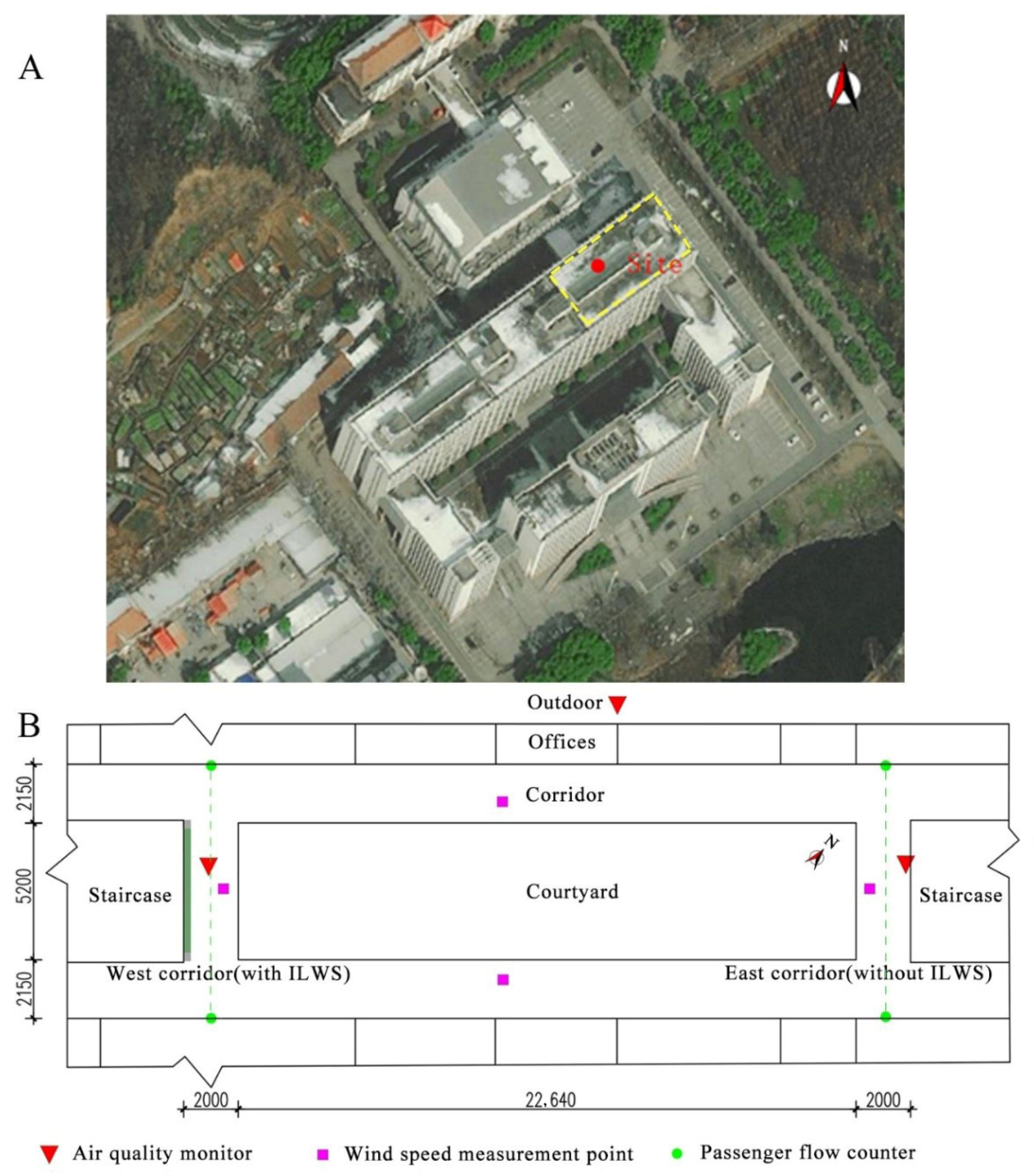
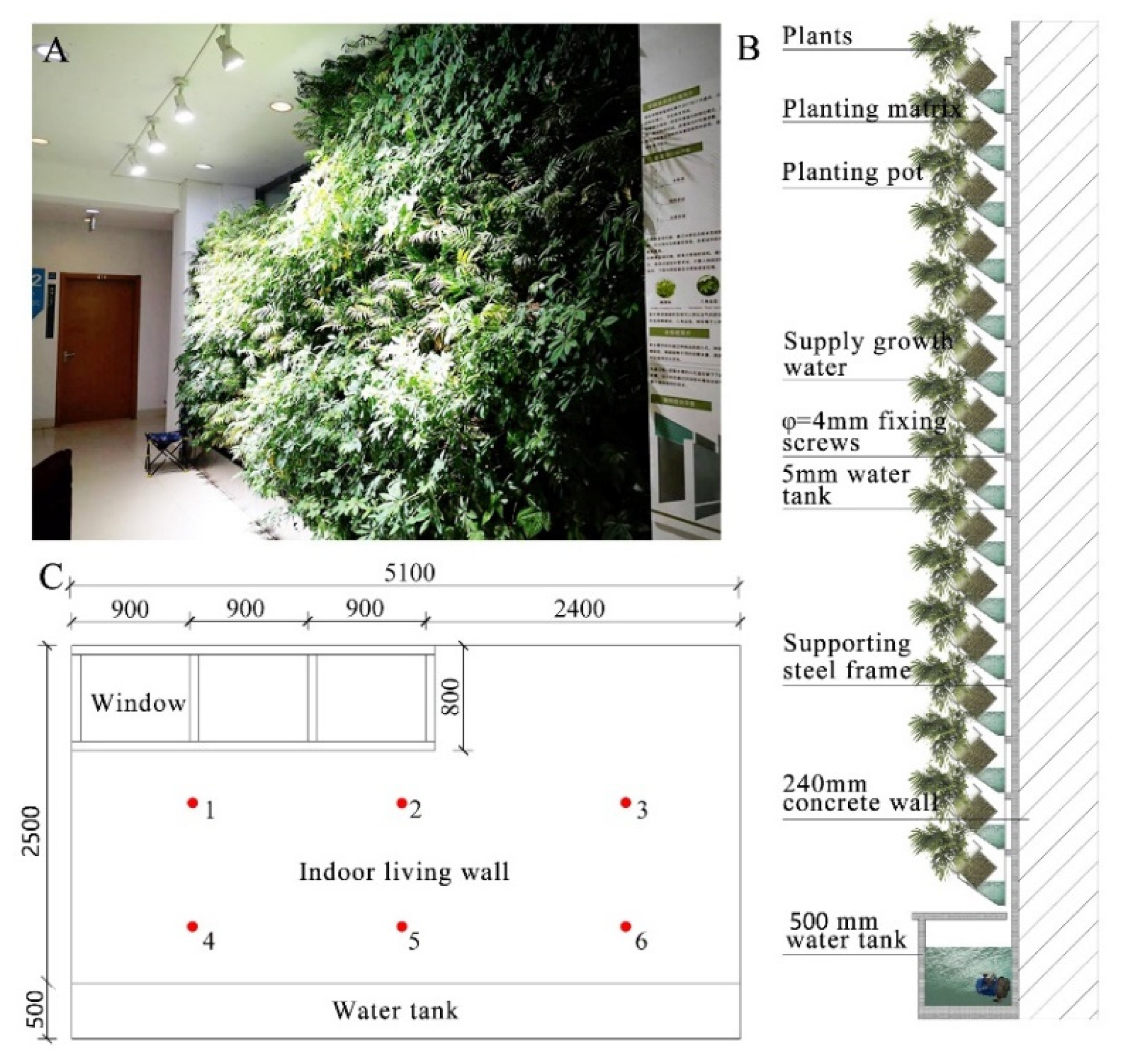

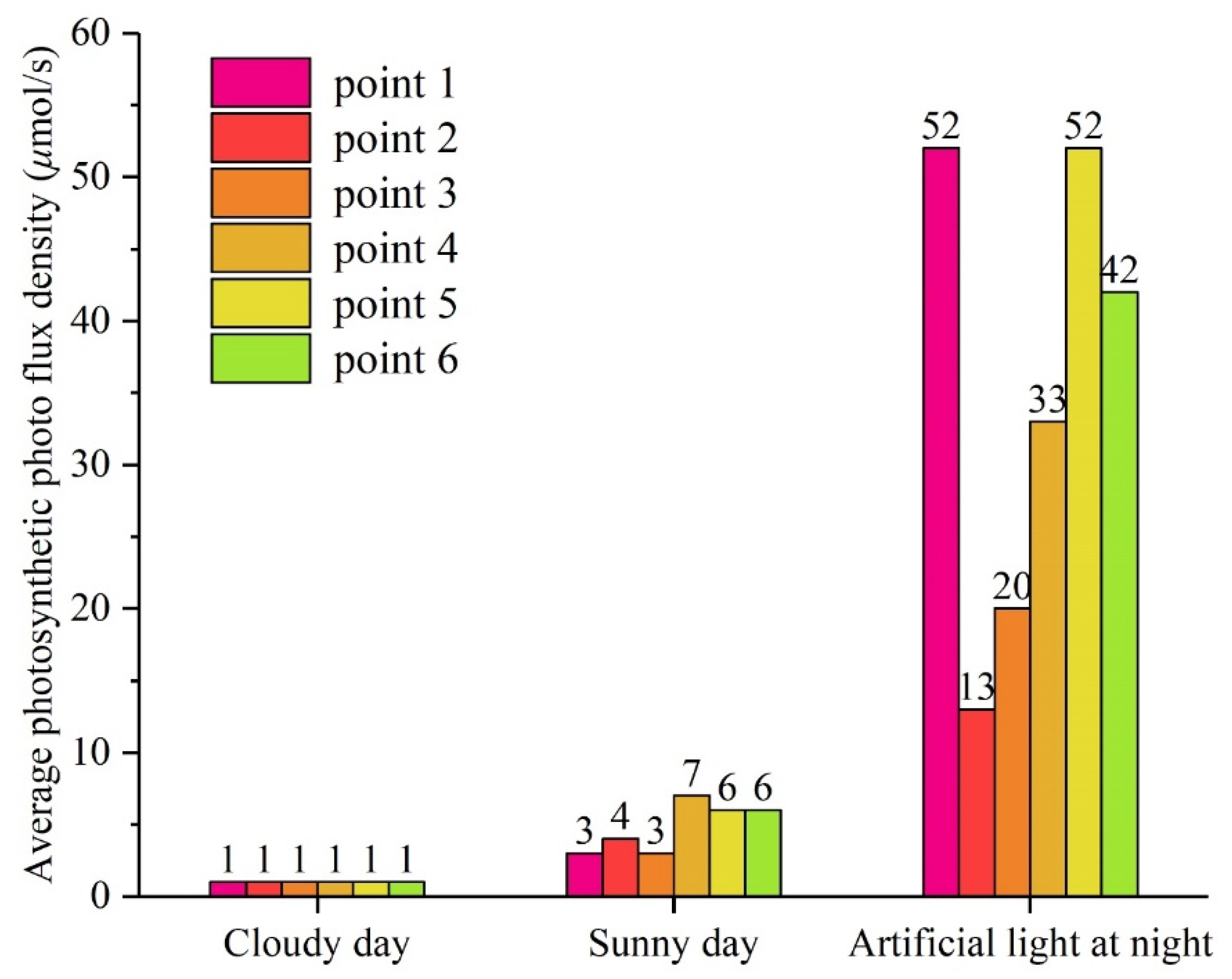
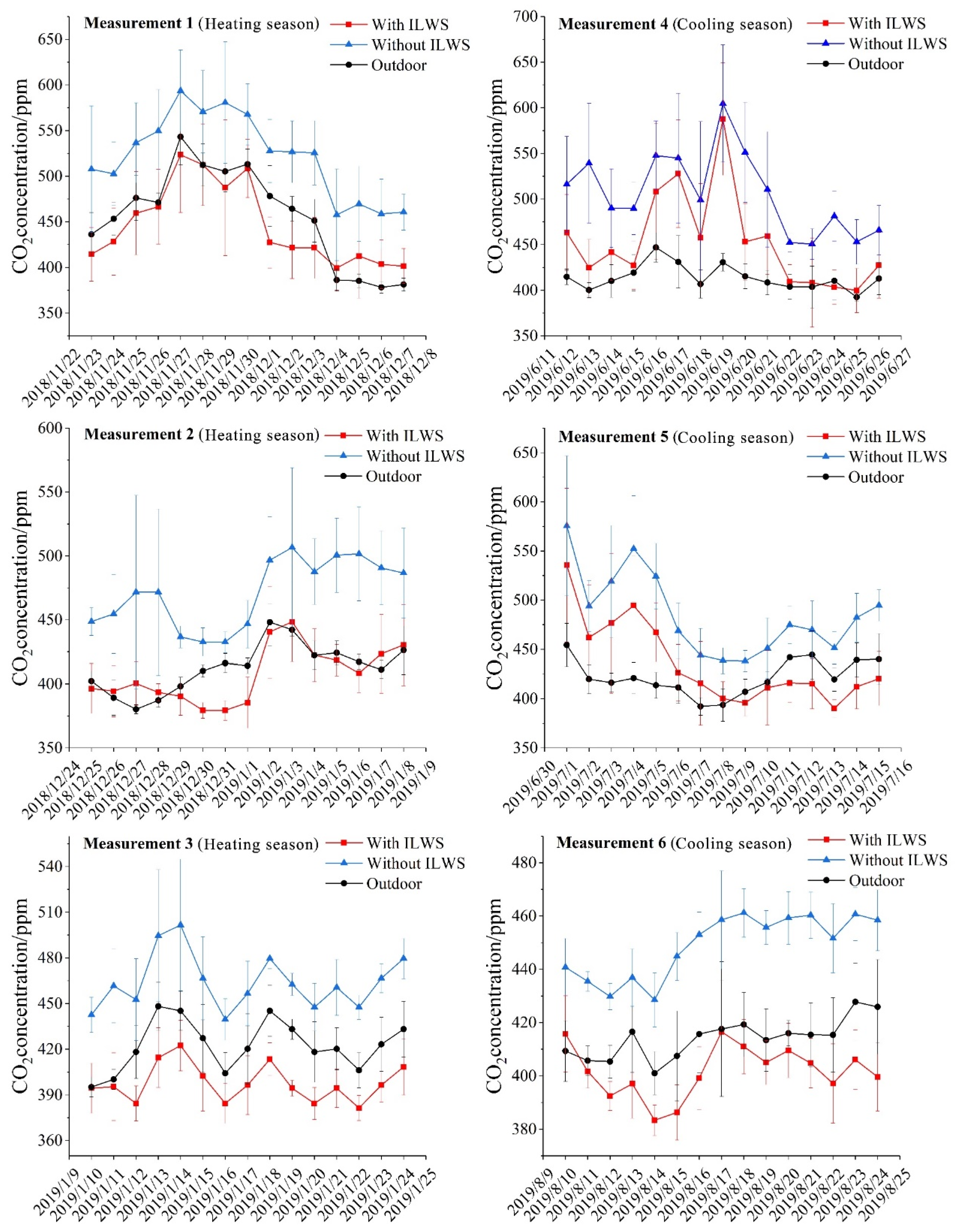



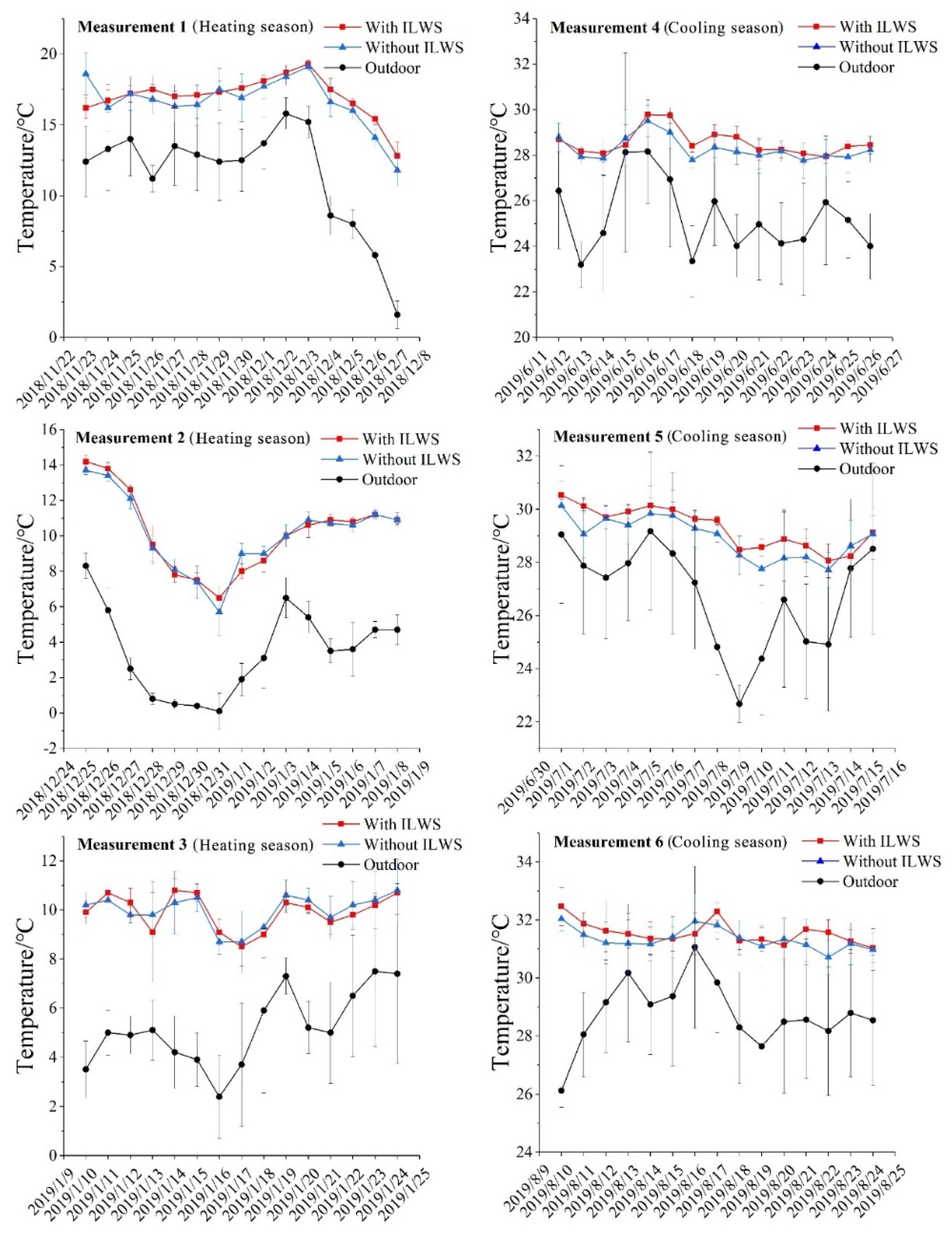

| Name of the Plant | Light Requirement | Growth Cycle Category | Applied Area (m2)/Proportion (%) |
|---|---|---|---|
| Schefflera octophylla (Lour.) Harms | shade-loving | Perennial | 5.2/49.1% |
| Fatsia japonica (Thunb.) Decne. et Planch | shade-loving | Perennial | 2.1/19.8% |
| Chamaedorea elegans Mart | shade-loving | Perennial | 3.3/31.1% |
| Building Components | Specifications |
|---|---|
| Floor height | 4 m, floor to floor height |
| Wall | 240 mm hollow concrete small blocks wall with paint finish |
| Ceiling | light steel keel asbestos board suspended ceiling |
| Floor | 120 mm cast-in-place concrete with floor tile finish |
| Glazing | 6 mm single glazing |
| HVAC system | no HVAC system in corridors and other public spaces, single air-conditioner in separated offices |
| Parameters | Devices | Type | Measurement Method | Accuracy |
|---|---|---|---|---|
| CO2 (ppm) | Air quality monitor (BohuBH-03) | SenseonAir S8 PMS7003 Senseon SHT20 | 7/24 h, automatic recording frequency is 1 time/min | ±3% |
| PM0.3–1 (μg/m3) | ±2% | |||
| PM1–2.5 (μg/m3) | ±2% | |||
| PM2.5–10 (μg/m3) | ±2% | |||
| Temperature (°C) | ±0.2 °C | |||
| Relative humidity (%) | ±2% | |||
| PPFD (μmol/s) | PAR meter | Apogee MQ-500 | Manual measurement | ±5% |
| Dimension (m) | Laser rangefinder | Bosch GLM30 | Manual measurement | ±1.0 mm |
| Wind speed (m/s) | Digital anemometer | PM6252B | 7/24 h, automatic recording frequency is 1 time/15 min | ±2% |
| Human traffic | Passenger flow counter | iDTK | 7/24 h, automatic recording | N/A |
| Season | Average Air Movement Speed (m/s) | Difference | MRE | t-Test Sig. | 95% Confidence Interval of the Difference | ||
|---|---|---|---|---|---|---|---|
| With ILWS | Without ILWS | Lower | Upper | ||||
| Heating season | 0.0859 | 0.0871 | 0.0012 | 1.1% | 0.377 | −0.0039 | 0.0015 |
| Cooling season | 0.1187 | 0.1216 | 0.0029 | 2.4% | 0.147 | −0.0068 | 0.0010 |
| Season | Average | Difference | MRE | t-Test Sig. | 95% Confidence Interval of the Difference | ||
|---|---|---|---|---|---|---|---|
| With ILWS | Without ILWS | Lower | Upper | ||||
| Heating season | 586 | 559 | −28 | −5.0% | 0.404 | −37.76 | 91.09 |
| Cooling season | 338 | 327 | −11 | −3.7% | 0.392 | −15.20 | 37.60 |
| Measurements | Average CO2 (ppm) | Difference | MRE | t-test Sig. | 95% Confidence Interval of the Difference | |||
|---|---|---|---|---|---|---|---|---|
| With ILWS | Without ILWS | Lower | Upper | |||||
| Measurement 1 | 445.8 | 522.3 | 455.7 | 76.5 | 17% | 0.000 | −12.91 | −10.52 |
| Measurement 2 | 407.4 | 471.0 | 412.6 | 63.6 | 16% | 0.060 | −0.03 | 1.51 |
| Measurement 3 | 397.8 | 464.0 | 422.5 | 66.2 | 17% | 0.039 | 0.02 | 1.01 |
| Measurement 4 | 453.2 | 506.3 | 413.8 | 53.1 | 12% | 0.000 | 12.08 | 15.03 |
| Measurement 5 | 435.9 | 485.2 | 422.1 | 49.3 | 11% | 0.000 | 16.90 | 19.17 |
| Measurement 6 | 401.7 | 449.0 | 414.1 | 47.3 | 12% | 0.000 | 18.55 | 19.16 |
| Parameter | Measurements | Average PM0.3–1 (μg/m3) | Difference (μg/m3) | MRE | t-Test Sig. | 95% Confidence Interval of the Difference | |||
|---|---|---|---|---|---|---|---|---|---|
| PM0.3–1 | With ILWS | Without ILWS | Outdoor | Lower | Upper | ||||
| Measurement 1 | 60.9 | 72.0 | 58.8 | 11.1 | 15% | 0.000 | −9.62 | −8.35 | |
| Measurement 2 | 48.4 | 55.0 | 46.8 | 6.6 | 12% | 0.000 | −6.50 | −5.63 | |
| Measurement 3 | 56.6 | 67.1 | 58.9 | 10.5 | 16% | 0.000 | −11.56 | −10.62 | |
| Measurement 4 | 36.0 | 36.1 | 31.1 | 0.1 | 0.3% | 0.189 | −0.41 | 0.080 | |
| Measurement 5 | 34.2 | 34.8 | 30.1 | 0.6 | 2% | 0.000 | −0.80 | −0.44 | |
| Measurement 6 | 24.2 | 25.4 | 22.3 | 1.2 | 5% | 0.000 | −1.38 | −0.98 | |
| PM1–2.5 | |||||||||
| Measurement 1 | 107.3 | 125.3 | 111.6 | 18 | 14% | 0.000 | −13.84 | −11.44 | |
| Measurement 2 | 83.5 | 92.3 | 82.4 | 8.8 | 10% | 0.000 | −8.74 | −7.06 | |
| Measurement 3 | 107.5 | 119.8 | 109.3 | 12.3 | 10% | 0.000 | −16.19 | −14.20 | |
| Measurement 4 | 53.2 | 58.0 | 50.7 | 4.8 | 8% | 0.000 | −5.03 | −4.23 | |
| Measurement 5 | 50.6 | 56.0 | 49.7 | 5.4 | 10% | 0.000 | −5.72 | −5.12 | |
| Measurement 6 | 33.3 | 38.4 | 33.2 | 5.1 | 13% | 0.000 | −5.39 | −4.78 | |
| PM2.5–10 | |||||||||
| Measurement 1 | 133.2 | 143.9 | 133.3 | 10.7 | 7% | 0.000 | −5.97 | −3.06 | |
| Measurement 2 | 103.8 | 109.1 | 100.3 | 5.3 | 5% | 0.000 | −5.82 | −3.85 | |
| Measurement 3 | 140.9 | 143.6 | 134.3 | 2.7 | 2% | 0.000 | −8.84 | −6.38 | |
| Measurement 4 | 65.2 | 70.1 | 60.4 | 4.9 | 7% | 0.000 | −5.60 | −4.69 | |
| Measurement 5 | 62.4 | 69.0 | 59.6 | 6.6 | 10% | 0.000 | −7.00 | −6.28 | |
| Measurement 5 | 39.7 | 46.0 | 37.8 | 6.3 | 14% | 0.000 | −6.75 | −5.96 | |
| Season | Measurements | Average Temperature (°C) | Difference (°C) | MRE | t-Test Sig. | 95% Confidence Interval of the Difference | |||
|---|---|---|---|---|---|---|---|---|---|
| With ILWS | Without ILWS | Outdoor | Lower | Upper | |||||
| Heating season | Measurement 1 | 17.0 | 16.6 | 11.4 | −0.4 | −2.4% | 0.000 | 0.45 | 0.51 |
| Measurement 2 | 10.2 | 10.1 | 4.5 | −0.1 | −1.0% | 0.890 | −0.04 | 0.05 | |
| Measurement 3 | 9.9 | 10.0 | 5.2 | 0.1 | 1.0% | 0.000 | 0.03 | 0.07 | |
| Cooling season | Measurement 4 | 28.6 | 28.3 | 25.3 | −0.3 | −1.2% | 0.000 | 0.27 | 0.30 |
| Measurement 5 | 29.3 | 28.9 | 26.8 | −0.4 | −1.4% | 0.000 | 0.41 | 0.45 | |
| Measurement 6 | 31.6 | 31.3 | 28.8 | −0.3 | −1.0% | 0.000 | 0.21 | 0.24 | |
| Season | Measurements | Average Relative Humidity (%) | Difference | MRE | t-Test Sig. | 95% Confidence Interval of the Difference | |||
|---|---|---|---|---|---|---|---|---|---|
| With ILWS | Without ILWS | Outdoor | Lower | Upper | |||||
| Heating season | Measurement 1 | 63.5 | 61.5 | 73.4 | −2.0 | −3.3% | 0.000 | 2.40 | 2.65 |
| Measurement 2 | 54.2 | 52.3 | 69.1 | −3.9 | −7.5% | 0.000 | 3.80 | 4.25 | |
| Measurement 3 | 57.1 | 52.7 | 71.0 | −4.4 | −8.3% | 0.000 | 3.01 | 3.30 | |
| Cooling season | Measurement 4 | 63.5 | 61.3 | 71.6 | −1.9 | −3.1% | 0.000 | 2.07 | 2.34 |
| Measurement 5 | 67.6 | 65.9 | 75.2 | −1.7 | −2.6% | 0.000 | 1.44 | 1.65 | |
| Measurement 6 | 63.2 | 61.0 | 67.5 | −2.2 | −3.6% | 0.000 | 2.15 | 2.38 | |
| Reference | Köppen Climatic Zone | Area of ILWS (m2) | Function & Volume of Space (m3) | Impact on CO2 Concentration (μg/m3/%) | Impact on PMs Concentration (μg/m3/%) | Impact on Temperature (°C/%) | Impact on Relative Humidity |
|---|---|---|---|---|---|---|---|
| This study | Cfa | 10.6 | Corridor 30.6 | 49.9–68.8↓ 12–17%↓ | PM0.3–1: 1.9–9.4↓ 2.4–14.3%↓ PM1–2.5: 5.1–13.3↓ 10.3–11.3%↓ PM2.5–10: 5.9–6.2↓ 4.7–10.3%↓ | 0.1–0.4↑ 1–2.4%↑ | 3.1–6.4%↑ |
| Ghazalli et al. [39] | Cfa | 3.2 | Corridor 27 | Not tested | PM2.5: 48.5%↓ PM10: 82.6%↓ >PM10: 65.5%↓ | → | 2–3%↑ |
| Su and Lin [40] | Cfa | 5.72 | Laboratory 38.88 | 21.3%↓ | Not tested | 2.5 °C↓ 11% ↓ | 2–4%↑ |
| Gunawardena et al. [50] | Cfb | 91 | Atrium Not mentioned | Not tested | Not tested | 0.2–0.7 °C↑ 1–3.1%↑ | 2.3–2.4%↑ |
| Tudiwer et al. [42] | Cfb | 5.5 | Classroom 202 | 3.5%↓ | Not tested | → | 25.5%↑ |
| Urrestarazu et al. [51] | Csa | 8 | Main hall 351 | Not tested | Not tested | 0.8–4.8 °C↓ 2.6–19.6%↓ | 6–21.3%↑ |
| Rafael et al. [52] | Csa | 7.74 | Hall 195.4 | Not tested | Not tested | 4 °C↑ | 15%↑ |
| Poorova et al. [53] | Dfb | 3 | Classroom 207.2 | 127.9↓ 14%↓ | Not tested | 1.7 °C↓ 4.6%↓ | 1.4%↑ |
| Shao et al. [54] | Cfa | 6.86 | Office 88.92 | 25.7%–34.3%↓ | Not tested | Not tested | Not tested |
Publisher’s Note: MDPI stays neutral with regard to jurisdictional claims in published maps and institutional affiliations. |
© 2021 by the authors. Licensee MDPI, Basel, Switzerland. This article is an open access article distributed under the terms and conditions of the Creative Commons Attribution (CC BY) license (https://creativecommons.org/licenses/by/4.0/).
Share and Cite
Shao, Y.; Li, J.; Zhou, Z.; Zhang, F.; Cui, Y. The Impact of Indoor Living Wall System on Air Quality: A Comparative Monitoring Test in Building Corridors. Sustainability 2021, 13, 7884. https://doi.org/10.3390/su13147884
Shao Y, Li J, Zhou Z, Zhang F, Cui Y. The Impact of Indoor Living Wall System on Air Quality: A Comparative Monitoring Test in Building Corridors. Sustainability. 2021; 13(14):7884. https://doi.org/10.3390/su13147884
Chicago/Turabian StyleShao, Yiming, Jiaqiang Li, Zhiwei Zhou, Fan Zhang, and Yuanlong Cui. 2021. "The Impact of Indoor Living Wall System on Air Quality: A Comparative Monitoring Test in Building Corridors" Sustainability 13, no. 14: 7884. https://doi.org/10.3390/su13147884
APA StyleShao, Y., Li, J., Zhou, Z., Zhang, F., & Cui, Y. (2021). The Impact of Indoor Living Wall System on Air Quality: A Comparative Monitoring Test in Building Corridors. Sustainability, 13(14), 7884. https://doi.org/10.3390/su13147884








